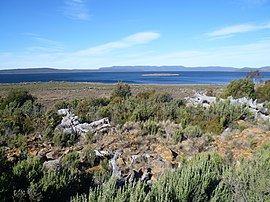| Liawenee Tasmania | |||||||||
|---|---|---|---|---|---|---|---|---|---|
 | |||||||||
| Coordinates | 41°53′58.92″S 146°40′9.84″E / 41.8997000°S 146.6694000°E | ||||||||
| Population | 2 (2011 census - Miena Dam incl. Liawenee)[1] | ||||||||
| Established | 11 June 1920 | ||||||||
| Postcode(s) | 7030 | ||||||||
| Elevation | 1,065 m (3,494 ft) | ||||||||
| Location | 122 km (76 mi) NNW[2] of Hobart | ||||||||
| LGA(s) | Central Highlands Council | ||||||||
| State electorate(s) | Lyons | ||||||||
| Federal division(s) | Lyons | ||||||||
| |||||||||
Liawenee (/laɪ.əˈwiːni/) is a small town in Tasmania, Australia built near Great Lake and the River Ouse, and was established on 11 June 1920. The town is an ex-Hydro village and now a residence for Inland Fisheries Services (IFS) and a Tasmania Police station. It is known for its exceptional fishing at nearby Great Lake and hosts several trout fishing events.[3]
Liawenee is the coldest permanently-inhabited place in Australia.
In January 2020, Liawenee’s population doubled to two, that being the police officer and an Inland Fisheries Service (IFS) officer now stationed permanently in the town.
- ^ Australian Bureau of Statistics (31 October 2012). "Miena (State Suburb)". 2011 Census QuickStats. Retrieved 27 January 2016.
- ^ "Information about Liawenee(7030) in Tasmania". Myboot.com.au. Retrieved 8 May 2010.
- ^ "Liawenee Open Weekend — Fishing Tasmania". Fishingtasmania.net. 22 February 1999. Archived from the original on 23 July 2011. Retrieved 8 May 2010.
